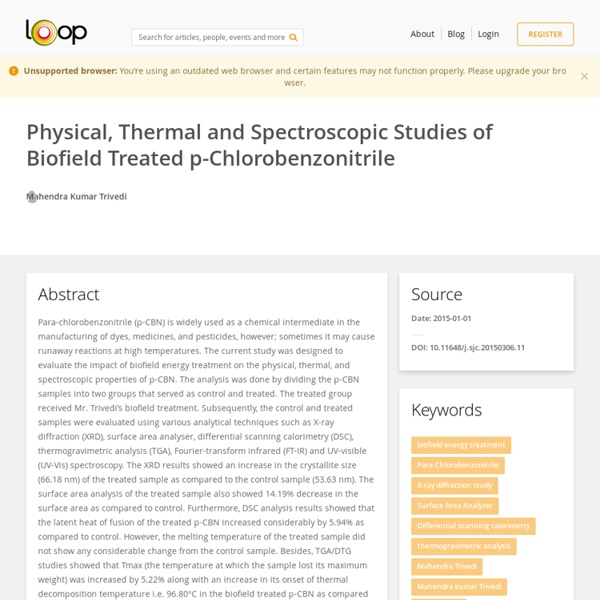



Spectroscopic Analysis of P-Chloro Benzonitrile: Impact of Human Energy Description Para-chlorobenzonitrile (p-CBN) is widely used as a chemical intermediate in the manufacturing of dyes, medicines, and pesticides, however; sometimes it may cause runaway reactions at high temperatures. The current study was designed to evaluate the impact of biofield energy treatment on the physical, thermal, and spectroscopic properties of p-CBN. The analysis was done by dividing the p-CBN samples into two groups that served as control and treated. The treated group received Mr. Citation Information Mahendra Kumar Trivedi, Alice Branton, Dahryn Trivedi, Gopal Nayak, Ragini Singh, Snehasis Jana.
Analytical Study of Para Chloro Benzonitrile Title: Physical, Thermal and Spectroscopic Studies of Biofield Treated p-Chlorobenzonitrile Publication: Science Journal of Chemistry Select license: Creative Commons Attributions-NonCommercial-ShareAlike 10.11648/j.sjc.20150306.11 Updated: November 21st, 2016 Abstract: Para-chlorobenzonitrile (p-CBN) is widely used as a chemical intermediate in the manufacturing of dyes, medicines, and pesticides, however; sometimes it may cause runaway reactions at high temperatures.
Mahendra Kumar Trivedi | Biography Mahendra Kumar Trivedi completed his Bachelor’s degree in Mechanical Engineering in 1985 and worked as an Engineer for 10 years. In 1995, Mr. Trivedi discovered that he has the unique ability to harness the energy from the universe and transmit it to anywhere on earth, infusing it into living organisms and nonliving materials to optimize their potential. Mahendra Trivedi on iScience About Mahendra Trivedi earned his 5-year Bachelor’s degree in Mechanical Engineering in 1985 and worked as an Engineer for 10 years. In 1995, Mr. Trivedi discovered that he had the unique ability to harness the energy from the universe and transmit it to anywhere on the globe, infusing it into living organisms and nonliving materials, thus optimizing their potential. Research Although Mr. He amassed a collection of over 4,000 scientific studies in many life sciences and material sciences, including: agriculture, livestock, biotechnology, microbiology, materials science, genetics, cancer and human health and has several dozens of publications in leading international peer-reviewed scientific journals, all in support to the dramatic results reported through human testimonials, thus excluding the possibility of the placebo effect. Mr. Mr. You can read more about Mr. 1). 2). 3). 4). 5). 6). 7). 8). 9).
Human Energy Treatment of 1,2,3 Trimethoxybenzene Citation: Trivedi MK, Tallapragada RM, Branton A, Trivedi D, Nayak G, et al. (2015) Physical, Thermal and Spectral Properties of Bioeld Treated 1,2,3-Trimethoxybenzene. J Develop Drugs 4: 136. doi:10.4172/2329-6631.1000136 Page 7 of 8 Volume 4 • Issue 4 • 1000135 J Develop Drugs ISSN: 2329-6631 JDD an open access journal peaks as compared to the control. treatment may not aect the energy gap of highest occupied molecular orbital and lowest unoccupied molecular orbital (HOMO–LUMO gap). ough this was the rst attempt to investigate the impact of bioeld energy treatment on physicochemical properties of 1,2,3- trimethoxybenzene. to elucidate the exact mechanism of bioeld energy eect on physical, structural properties of the compound. techniques such as NMR, GC-MS, and TGA-FTIR will be used to get further detailed insights about the structural/thermal changes in the bioeld treated 1,2,3- trimethoxybenzene. Conclusions In summary, the XRD studies revealed the signicant increase to the control. 1. 2.
Biofield Impact on Biotype Number of R. Ornithinolytica Description Raoultella ornithinolytica is belongs to the family of Enterobacteriaceae, a Gram-negative encapsulated aerobic bacillus associated with bacteremia and urinary tract infections. As biofield therapy is increasingly popular in biomedical heath care, so present study aimed to evaluate the impact of Mr. Citation Information Mahendra Kumar Trivedi. 1,2,3 Trimethoxybenzene- Impact of Spiritual Energy Description Study background: 1,2,3-Trimethoxybenzene is an important compound used for the synthesis of chemicals and pharmaceutical agents. The objective of this study was to investigate the influence of biofield energy treatment on the physical, thermal and spectral properties of 1,2,3-trimethoxybenzene. Citation Information Trivedi MK, Tallapragada RM, Branton A, Trivedi D, Nayak G, et al. (2015) Physical, Thermal and Spectral Properties of Biofield Treated 1,2,3-Trimethoxybenzene.
Citrobacter Braakii – Study of Biochemical Characteristics Abstract Citrobacter braakii (C. braakii) is widespread in nature, mainly found in human urinary tract. The current study was attempted to investigate the effect of Mr. Trivedi’s biofield treatment on C. braakii in lyophilized as well as revived state for antimicrobial susceptibility pattern, biochemical characteristics, and biotype number. Keywords: Citrobacter braakii; Antimicrobial susceptibility; Biofield treatment; Biochemical reaction; Biotype; 16S rDNA analysis; Gramnegative bacteria; Enterobacteriaceae Abbreviations: MDR: Multi-Drug Resistant;ATCC: American Type Culture Collection; NBPC 30: Negative Breakpoint Combo 30; MIC: Minimum Inhibitory Concentration; OTUs: Operational Taxonomic Units; NCBI: National Center for Biotechnology Information; MEGA: Molecular Evolutionary Genetics Analysis; PCR: Polymerase Chain Reaction; RDP: Ribosomal Database Project; HBMEC: Human Brain Microvascular Endothelial Cells . Introduction Materials and Methods Experimental design Group IIB – Study I 1.